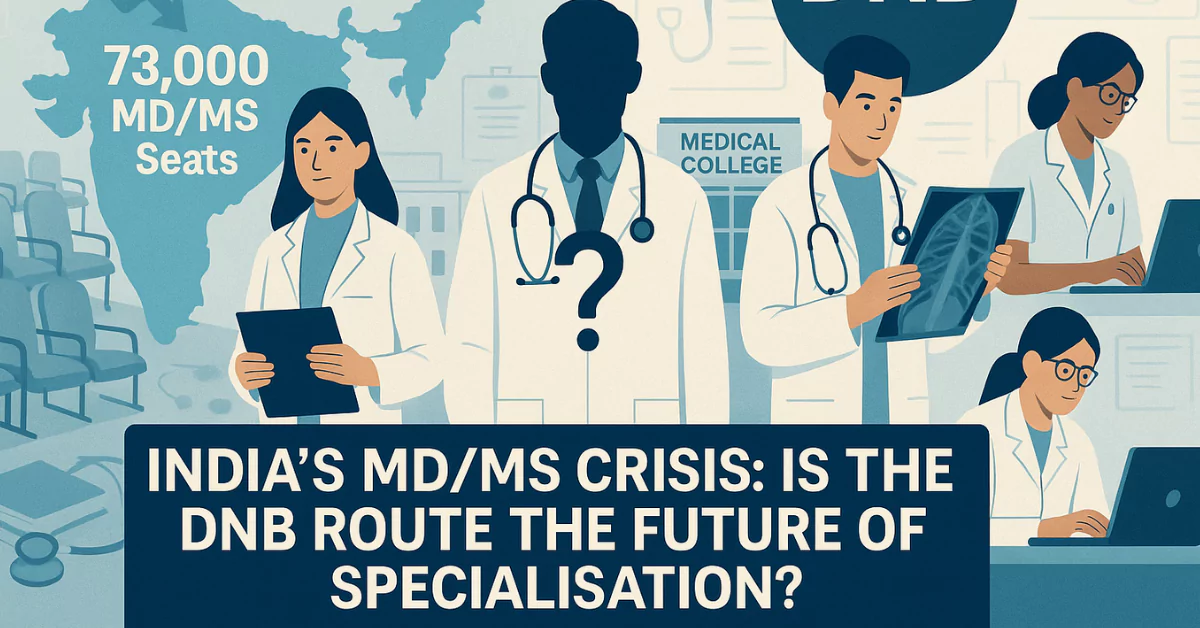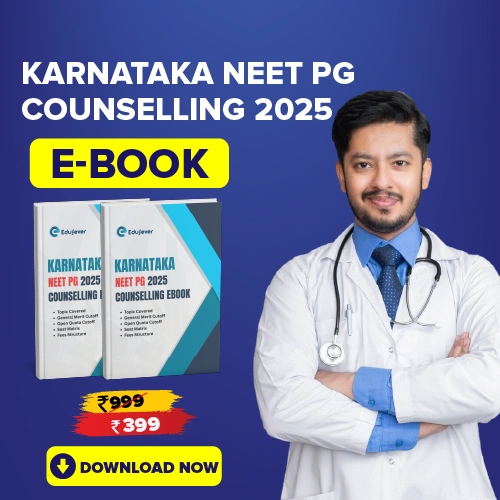Future of Medical Specialisation in India: Medical education in India has expanded rapidly in recent years. From 2014 to 2024, the number of medical colleges rose from about 387 to 780. MBBS seats increased by roughly 130%, reaching ~118,137 in 2024. PG seats (MD, MS, PG Diploma) similarly increased by ~135% in the same period to ~73,157.
Despite these gains, demand for specialisation (MD/MS) outstrips supply, creating a crisis: many MBBS graduates cannot secure MD/MS seats in their chosen specialty. The Diplomate of National Board (DNB) and PG diplomas have thus gained attention as alternative routes.
This article explores whether the DNB route is helping mitigate the MD/MS crisis, compares its pros and cons, examines FMGE/NExT’s role, and considers whether these alternatives constitute sustainable solutions.
Understanding the Crisis: MD/MS Seat Shortage
Statistics of MD/MS vs MBBS Graduates
| Metric | Value (2024) |
|---|---|
| Number of Medical Colleges | 784 |
| MBBS Seats | 118,137 |
| PG Seats (MD/MS/PG Diploma) | ~73,157 |
| DNB / DNB Diploma / CPS / FNB Seats | ~13,000-18,000 in many counts |
So, a significant number of MBBS graduates find themselves unable to secure MD/MS specialisation in their preferred subject. Other bottlenecks include high competition, cost of private seats, geographic imbalance, and limited availability of certain specialties.
What is the DNB Route?
The Diplomate of National Board (DNB) is a postgraduate medical degree awarded by the National Board of Examinations in Medical Sciences (NBEMS). It is awarded in broad specialties (post MBBS) and super-specialties (post MD/MS/DNB → DrNB).
Additionally, there are PG Diploma courses, shorter-duration specialisation paths, also recognised in various specialties. These are also part of the alternatives many aspirants consider.
MD/MS vs Diplomate of National Board (DNB)
Recognition & Accreditation
- On paper, DNB is equivalent to MD/MS/DM/MCh for all purposes, per NBEMS regulations.
- For academic positions, government jobs, specialist roles, both qualifications are legally accepted. However, there are perceptual biases; in many institutions, MD/MS degrees may be preferred over DNB in hiring. (Not always formally stipulated but seen in practice).
Training Quality & Clinical Exposure
| Factor | MD/MS (Medical College) | DNB (NBEMS Accredited Hospitals) |
|---|---|---|
| Hospital setting | Teaching hospitals, college-associated clinical cases | Accredited hospitals (private & public), sometimes high case loads, but variation in exposure depending on hospital infrastructure |
| Faculty oversight | College teaching staff, mandatory NMC norms | NBEMS accreditation criteria, but variability in faculty/supervision depending on the hospital |
| Research exposure | Greater emphasis in college environments, thesis, and college-level research | Possible, but may be less structured in some DNB hospitals; variable access to research resources |
| Exit examinations | University exams, NMC recognised | DNB exit exam (final theory + practical) under NBEMS; known to have a more rigorous/standardised final exam in many cases (but pass rates lower) |
Exams, Difficulty & Pass Rates
- DNB exams are considered challenging; pass rates are often lower than MD/MS in some broad specialties.
- MD/MS candidates take university/NMC exams; DNB candidates take NBEMS exams. The standardisation is more centralised in DNB exit exams.
Cost & Availability
- DNB seats often exist in hospitals in locations where MD/MS seats are fewer, sometimes in private or corporate hospitals.
- PG Diplomas and DNB offer more options in non-clinical / para-clinical specialties and in hospitals without full medical college status.
- Costs may vary: some DNB seats are under private hospitals with potentially high fees, but many are government-run or affiliated.
Growth of DNB & PG Diploma Courses: Have They Helped?
Trends in Seat Expansion
- The number of PG medical seats (including DNB, CPS, PG Diploma) has nearly doubled since 2014. From ~31,185 seats before 2014 to ~65,335 in 2022, which includes ~13,246 DNB/FNB seats.
- In NEET PG 2025, there are ~4,800 DNB broad specialty seats plus additional DNB Diploma / PG Diploma seats.
Subject Areas with Diploma / DNB Increases
Some specialties where PG Diploma and DNB seat increases have been notable include:
| Specialty | Increase or Notable Numbers |
|---|---|
| Anesthesia, General Medicine, General Surgery | These have seen additional DNB seats in AIQ rounds. |
| OB/GYN, Radiodiagnosis, Pediatrics | Diploma courses (DGO, DCH, DOPHTHAL, etc.) have had seat increases. |
FMGE & NExT: Implications for PG Training and the DNB Route
What are FMGE & NExT?
- FMGE (Foreign Medical Graduate Examination) is the screening/licensing exam for Indian citizens (and OCI) who obtain MBBS degrees abroad, required for practice registration in India.
- NExT (National Exit Test) is a proposed unified exam that will serve multiple purposes: final MBBS assessment, licensing exam, and entrance test for PG (MD/MS/DNB). Foreign graduates will also use NExT in lieu of FMGE.
How NExT Affects DNB vs MD/MS Landscape
| Aspect | Under Current System (Pre-NExT) | Under NExT (Proposed / Transition) |
|---|---|---|
| Licensing practice | Indian MBBS + State registration; FMG required FMGE | All graduates (Indian & foreign) have to pass NExT to be licensed |
| PG entrance | Through NEET PG for MD/MS/DNB; FMGE separately for foreign grads | Entrance merit for PG specialisation (MD/MS/DNB) will be based on NExT score/rank |
| Uniformity | Variability in quality; separate exams; different pass criteria | Potentially more standardised assessment; a common yardstick for clinical & theoretical competence |
Challenges & Concerns with NExT Implementation
- Ensuring the infrastructure and capacity to conduct a high-stakes national exit/licensing test for tens of thousands of students per year.
- Transition rules for current MD/MS/DNB/abroad graduates.
- Whether NExT will fairly assess clinical skills, hospital setting differences, and variability in training quality.
- How can DNB candidates’ previous counts/hospital experiences be normalised or considered?
Does DNB Solve the Crisis? Strengths vs Limitations
Strengths of DNB / Diploma Routes
- Increasing PG seat numbers: helps reduce the gap between MBBS graduate numbers and PG specialisation availability.
- Broader geographic spread: many DNB hospitals in areas where full medical colleges are less common.
- Flexibility: for hospitals that cannot run a full MD/MS, DNB accreditation allows specialisation training.
- Recognition: legally MD/MS equivalent, especially under NBEMS/NMC frameworks.
Limitations & Gaps
- Variability in training quality across DNB-accredited hospitals (some may lack in specific case exposure or academic environment).
- Lower pass rates for DNB in some specialties, may discourage aspirants.
- Perception bias: In academia or certain government jobs, MD/MS degrees may still be preferred.
- Diploma courses are limited in number and duration; they may not always be seen as equal to full specialisation in terms of depth.
Recommendations for Strengthening DNB & Alternative Routes
Standardise Training & Quality Assurance
- NBEMS, along with NMC, should enforce stricter audits of DNB hospitals for infrastructure, faculty, and case volumes.
- Uniform academic curriculum & research requirements for DNB similar to MD/MS in medical colleges.
Transparent Recognition & Career Pathways
- Ensure DNB doctors have equal eligibility for faculty positions, government specialist appointments, and institutional promotions.
- Public awareness campaigns to reduce bias and misinformation about DNB vs MD/MS.
Smooth Transition to NExT
- Clear communication of transition rules so current students, DNB trainees, and foreign graduates understand implications.
- Pilot runs to test NExT structure and fairness, especially for clinical components.
H3: Expansion in High-need Specialities & Regions
- Incentivise DNB seat creation, especially in underserved specialties (e.g., Critical Care, Emergency Medicine) and underserved regions (rural, hilly, remote).
- Increase PG Diploma courses in areas where full specialisation might be impractical due to infrastructure constraints.
Statistical Overview
| Metric | 2014 | 2025 |
|---|---|---|
| Medical Colleges | 387 | 784 |
| MBBS Seats | ~51,348 | ~1,18,137 |
| Total PG Seats (MD/MS/Diploma/CPS includes DNB) | ~31,185 | ~73,157 |
| DNB/FNB/CPS Seats Portion | ~13,246 (of PG) in 2022 | ~18,000+ depending on source |
The MD/MS crisis in India is real: despite significant expansion in medical colleges and MBBS seats, many MBBS graduates struggle to secure specialisation in preferred disciplines. The DNB route, along with PG diploma courses, provides important relief, increasing seats, spreading specialisation training across more institutions, and offering alternate pathways.
| NEET PG Counselling Guide 2025 | |
|---|---|
| MCC NEET PG Counselling Guide eBook 2025 | 📥 Download |
| DNB Counselling Book 2025 | 📥 Download |
However, DNB alone isn’t a panacea. For it to truly resolve the crisis, there must be:
- High and uniform quality in training and evaluation
- Equal recognition and reward in careers
- Clarity on new licensing systems like NExT and how they affect PG pathways
- Strategic expansion in specialties and geographic regions with deficits
With careful policy design, investment, and commitment to quality, DNB and related alternative pathways can significantly ease the MD/MS squeeze and help India produce more specialists aligned with healthcare needs.

